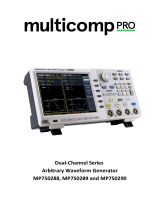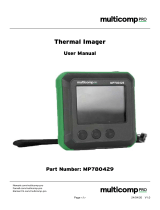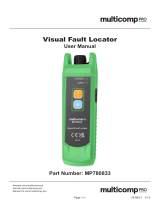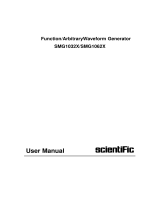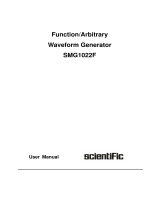Page is loading ...

i
MP7505 Series Dual-Channel
Arbitrary Waveform Generator
User Manual

ii
Table of Contents
1.General Safety Requirement ................................................................. 1
2.Safety Terms and Symbols ..................................................................... 2
3.General Inspection ................................................................................ 3
4.Quick Start ............................................................................................ 4
Front Panel Overview ................................................................................................................ 4
Rear Panel Overview ................................................................................................................. 6
Foot Stool Adjustment .............................................................................................................. 7
Power On ................................................................................................................................... 7
User Interface ............................................................................................................................ 8
5.Panel Operation .................................................................................... 9
Channel Setting ......................................................................................................................... 9
Select the channel for configuration ................................................................................. 9
Turn on/off channel output ............................................................................................... 9
Inter-channel ..................................................................................................................... 9
Waveform Setting ...................................................................................................................... 9
Output Sine Wave ........................................................................................................... 10
Set the frequency/period ........................................................................................ 10
Set the amplitude .................................................................................................... 11
Set the offset ........................................................................................................... 11
Set the high level ..................................................................................................... 11
Set the low level ...................................................................................................... 12
Set the start phase .................................................................................................. 12
Output Square Wave ....................................................................................................... 12
Output Ramp Wave ......................................................................................................... 12
Set the symmetry .................................................................................................... 13
Output Pulse Wave .......................................................................................................... 14
Set the pulse width/duty cycle ................................................................................ 15
Set the rising/falling time ........................................................................................ 17
Output Noise Wave ......................................................................................................... 17
Output Arbitrary Wave .................................................................................................... 17
Select build-in wave (including DC) ......................................................................... 18
Output Harmonic Wave................................................................................................... 23
Harmonic wave function overview ......................................................................... 23
Set the Fundamental Wave Parameters .................................................................. 24
Select the harmonic type ........................................................................................ 24
Set the harmonic order ........................................................................................... 24
Set the harmonic amplitude of each order ............................................................. 25
Set the harmonic phase of each order .................................................................... 25

iii
Output the Modulated Waves ................................................................................................. 25
AM (Amplitude Modulation) ........................................................................................... 26
DSB-AM (Double-Sideband AM) ..................................................................................... 27
FM (Frequency Modulation) ........................................................................................... 28
PM (Phase Modulation) .................................................................................................. 30
PWM (Pulse Width Modulation) ..................................................................................... 31
ASK (Amplitude Shift Keying) .......................................................................................... 32
FSK (Frequency Shift Keying) ........................................................................................... 34
PSK (Phase Shift Keying) .................................................................................................. 35
3FSK (3 Frequency Shift Keying) ...................................................................................... 36
4FSK (4 Frequency Shift Keying) ...................................................................................... 38
BPSK (Binary Phase Shift Keying) ..................................................................................... 39
QPSK (Quadrature Phase Shift Keying) ............................................................................ 40
OSK (Oscillation Shift Keying) .......................................................................................... 41
SUM (Sum Modulation)................................................................................................... 43
Generate Sweep (Sweep) ........................................................................................................ 44
Generate Burst (Burst) ............................................................................................................ 45
Set N-Cycle Burst ............................................................................................................. 46
Set Gated Burst ............................................................................................................... 47
Counter ................................................................................................................................... 49
Utility Function Setting ........................................................................................................... 50
Display Settings ............................................................................................................... 50
Brightness Control ................................................................................................... 50
Screen Saver ............................................................................................................ 50
Separator ................................................................................................................. 50
Date ......................................................................................................................... 51
Contrast ................................................................................................................... 51
CH1/2 Settings .................................................................................................................. 51
Sync ......................................................................................................................... 51
Load ......................................................................................................................... 52
I/O Setup ......................................................................................................................... 52
USB Device Type ...................................................................................................... 53
Network Setting ...................................................................................................... 53
System Settings ............................................................................................................... 54
Language ................................................................................................................. 54
Beeper ..................................................................................................................... 54
Clock Source ............................................................................................................ 54
Clock Output............................................................................................................ 54
Firmware Update .................................................................................................... 55
Edit the Arbitrary Wave (Edit) ................................................................................................. 55
File Store System (Store) ......................................................................................................... 56
Save the current arbitrary wave ...................................................................................... 56
Bring up arbitrary wave files in internal/external memory ............................................. 57
Erase waveforms from memory ...................................................................................... 58
Save/recall Instrument Settings ...................................................................................... 58

iv
Preset Settings (Preset) ........................................................................................................... 58
Restore to the factory setting .......................................................................................... 59
Restore to the user setting .............................................................................................. 63
Power-on setting ............................................................................................................. 63
Use Build-in Help (Help) .......................................................................................................... 63
6.Communicate with PC ......................................................................... 64
Using USB Port......................................................................................................................... 64
Using LAN Port ........................................................................................................................ 65
Connect Directly .............................................................................................................. 65
Connect through a Router ............................................................................................... 65
7.Troubleshooting .................................................................................. 67
8.Specification ....................................................................................... 68
Waveforms ...................................................................................................................... 68
Frequency Characteristics ............................................................................................... 68
Amplitude Characteristics ............................................................................................... 69
Signal Characteristics....................................................................................................... 69
Modulation Characteristics ............................................................................................. 71
Sweep Characteristics ..................................................................................................... 73
Burst Characteristics ........................................................................................................ 74
Counter Specifications .................................................................................................... 74
Input/Output Characteristics .......................................................................................... 74
General Specifications ..................................................................................................... 75
9.Appendix ............................................................................................. 76
Appendix A: Accessories.......................................................................................................... 76
Appendix B: General Care and Cleaning.................................................................................. 76

MP7505 Series User Manual
1
1. General Safety Requirement
Before any operations, please read the following safety precautions to avoid any
possible bodily injury and prevent this product or any other products connected from
damage. In order to avoid any contingent danger, this product must only be used
within the ranges specified.
Only the qualified technicians can implement the maintenance.
To avoid Fire or Personal Injury:
Use Proper Power Cord. Use only the power cord supplied with the product and certified
to use in your country.
Product Grounded. This instrument must be grounded through the power cord earth
conductor. To avoid electric shock, the grounding conductor must be earthed. The
product must be grounded properly before any connection with its input or output
terminal.
Limit operation to the specified measurement category, voltage, or amperage ratings.
Check all Terminal Ratings. To avoid fire or shock hazard, check all ratings and markers
on the instrument. Refer to the user's manual for more information about ratings before
connecting the instrument. Do not exceed any of ratings defined in the following section.
Do not operate without covers. Do not operate the instrument with covers or panels
removed.
Use Correct Fuse. Use only the specified type and rating fuse for this instrument.
Avoid exposed circuit. Do not touch exposed junctions and components when the
instrument is powered on.
Do not operate if in any doubt. If you suspect damage occurs to the instrument, have it
inspected by qualified service personnel before further operations.
Use your instrument in a well-ventilated area. Inadequate ventilation may cause an
increasing of temperature or damages to the instrument. Please keep the instrument
well ventilated, and inspect the air outlet and the fan regularly.
Do not operate in wet conditions. To avoid short circuit inside the instrument or electric
shock, never operate the instrument in a humid environment.
Do not operate in an explosive atmosphere.
Keep instrument surfaces clean and dry.

MP7505 Series User Manual
2
2. Safety Terms and Symbols
Safety Terms
Terms in this Manual. The following terms may appear in this manual:
Warning: Warning indicates the conditions or practices that could result in injury
or loss of life.
Caution: Caution indicates the conditions or practices that could result in damage
to this product or other property.
Terms on the Product. The following terms may appear on this product:
Danger: It indicates an injury or hazard may immediately happen.
Warning: It indicates an injury or hazard may be accessible potentially.
Caution: It indicates a potential damage to the instrument or other property might occur.
Safety Symbols
Symbols on the Product. The following symbol may appear on the product:
Hazardous Voltage
Refer to Manual
Protective Earth Terminal
Chassis Ground
Test Ground

MP7505 Series User Manual
3
3. General Inspection
After you get a new generator, it is recommended that you should make a check on the
instrument according to the following steps:
1. Check whether there is any damage caused by transportation.
If it is found that the packaging carton or the foamed plastic protection cushion has
suffered serious damage, do not throw it away first till the complete device and its
accessories succeed in the electrical and mechanical property tests.
2. Check the Accessories
The supplied accessories as described in Appendix A: Accessories of this manual. You can
check whether there is any loss of accessories with reference to this description. If there
is any accessory lost or damaged, please get in touch with the distributor of MULTICOMP
PRO responsible for this service or the MULTICOMP PRO's local offices.
3. Check the Complete Instrument
If it is found that there is damage to the appearance of the instrument, or the instrument
does not work normally, or fails in the performance test, please get in touch with the
MULTICOMP PRO's distributor responsible for this business or the MULTICOMP PRO's
local offices. If there is damage to the instrument caused by the transportation, please
keep all the packaging. With the transportation department or the MULTICOMP PRO's
distributor responsible for this business informed about it, a repairing or replacement of
the instrument will be arranged by the MULTICOMP PRO.

MP7505 Series User Manual
4
4. Quick Start
Front Panel Overview
16
4
9
17
12
7
6
13 12 10
5
11
8
3
14
15
Figure 4-1:
Front Panel overview
1 LCD Display the user interface
2
Menu selection
keys
Includes 6 keys to activate the corresponding menu
3 Mode keys Mod: Output the modulated waveform
Sweep: Scan the sine, square, ramp or arbitrary waveforms
Burst: Generate the sine, square, ramp, pulse or arbitrary
burst
4 Rotary control Change the currently selected value, also used to select the
character in the soft keyboard when the file location or file
name is entered.
When inserting a USB flash drive, press the rotary control to
save the current display screen to the folder of the USB flash
drive in BMP image format.

MP7505 Series User Manual
5
5 Direction key Move the cursor of the selected parameter
6 Operation keys Counter: Enter the counter interface
Edit: Enter the wavform edit interface
Preset: Enter the preset menu, set the reset parameter or
power-on parameter.
Utility: Set the utility function
Store: Save/load arbitrary waveform or instrument setup
Help:
To get contextual help for any front panel button or
menu softkey, press the button and then press the button for
which you need help.
7 Number
keypad
Input the parameter
8 CH2 Function
keys
CH2 button: After entering the waveform interface and
selecting the CH2 (the backlight of the button is on
), the
waveform and parameters of CH2 can be set after selection.
Blue Trigger button: CH2 manual trigger button. In sweep or
burst mode, when the trigger source is selected as “Manual”,
each press of this button will initiate a trigger.
On/Off button: Turns the output of the CH2 channel on or off.
When the output is turned on, the backlight of the button
lights up.
9
CH2 Sync
When Utility → CH1/2 Set → CH2 Sync turned on, this
terminal outputs a synchronization message that matches the
current configuration of CH2.
10
CH2 Out
Output CH2 signal
11
⇌ button
Display the inter-channel menu. You can copy the parameters
of one channel to the other, synchronize the frequency or
amplitude, and align the phase of two channel signals.
12
CH1 Out
Output CH1 signal
13
CH1 Sync
When Utility → CH1/2 Set → CH1 Sync
turned on, this
terminal outputs a synchronization message that matches the
current configuration of CH1.
14
CH1 Function
keys
CH1 button: After e
ntering the waveform interface and
selecting the CH1 (the backlight of the button is on
), the
waveform and parameters of CH1 can be set after selection.

MP7505 Series User Manual
6
Yellow Trigger button: CH1 manual trigger button. In sweep
or burst mode, when the trigger source i
s selected as
“Manual”, each press of this button will initiate a trigger.
On/Off button: Turns the output of the CH1 channel on or off.
When the output is turned on, the backlight of the button
lights up.
15 Waveform
Selection area
Includes: Sine , Square , Ramp , Pulse ,
Noise , Arb Wave , Harmonic Wave
. When a
waveform is selected, the corresponding backlight is lit.
16 USB interface Connect with external USB devices, e.g. U disk.
17 Power button Turn on/off the waveform generator.
Rear Panel Overview
Figure 4-2: Rear Panel Overview
1
Retractable handle
2
Air vents
3
AC input connector
AC input connector
4
Fuse Container
The place to install the fuse
8
7
6
10
9
5
3
4
1
2

MP7505 Series User Manual
7
5
Foot Stool
Tilt the signal generator for easy operation.
6
LAN interface The network port, which can be used to connect
with a PC.
7
USB Device interface Used to connect a USB type B controller. Can be
connected with PC, so the signal generator can be
controlled by the host computer software.
8
Lock Hole
You can lock the device to a fixed location using the
security lock (not supplied) to secure the device.
9
10MHz/In/Out/Counter
(refer to clock
input/output/counter
input) connector
It is default to receive the frequency meter input
signal. Used to output a 10MHz clock signal when
the instrument is set to an internal clock source and
Utility → System → CLK Output is turned on; it is
used to receive an external 10MHz clock signal
when the instrument is set to an external clock
source.
10
Mod/FSK/Trig
(modulation/trigger
input) connector
When modulating the waveform, outputting the
sweep frequency, and outputting the burst, the
signal accessed here can be used as an external
source.
Note: If one channel turns on AM, FM, PM, PWM or
OSK, and the other channel turns on ASK, FSK, PSK,
sweep or burst, and both channels are set to external
trigger, then the channel that sets the trigger source can
be accessed to external trigger, the other channel
automatically cancels the external trigger because of the
different external modulation signal types.
Foot Stool Adjustment
Unfold the foot stools on the bottom of the generator, as 5 Foot Stool in Figure 4-2.
Power On
(1) Connect the instrument to an AC power source using the power cord supplied
with the accessory.
Warning
:
To prevent electric shock, make sure the instrument is properly grounded.
(2) Press the power button on the front panel. The startup screen will display.

MP7505 Series User Manual
8
User Interface
Figure 4-3: User Interface
1
Display channel name and channel switch status
2
Current waveform or current mode
3
Trigger source
Internal: Internal modulation or internal trigger source
External: External modulation or external trigger source
Manual: Manual trigger source
4
Load, High Z indicates high resistance
5
This indicator is lit when the network is connected through the LAN
interface.
6
Lights up the indicator when connected to the USB Host via the USB
DEVICE interface.
7
When the instrument detects the USB flash drive, it lights up the
indicator.
8
Current menu name
9
Current waveform or mode setting menu
10
Counter brief information showing frequency value, period value and
11
Display current waveform
12
Start phase
13
Offset / low level, depending on the right highlit menu item
14
Amplitude / high level, depending on the right highlit menu item
15
Frequency/cycle, depending on the highlit menu item on the right

MP7505 Series User Manual
9
5. Panel Operation
Channel Setting
Select the channel for configuration
Before configuring waveform parameters, you must select the channel you want to
configure. Press CH1 or CH2 to select the corresponding channel, and the
corresponding channel area in the user interface will light up.
Turn on/off channel output
Press CH1 On/Off or CH2 On/Off button on the front panel to turn on/off output of
the corresponding channel. The backlight of the button will be lit when the
corresponding channel is tuned on.
Inter-channel
The instrument can copy the parameters of one channel to the other. If frequency or
amplitude of both channels are synchronized, when you change the parameter of
either channel, the parameter of the other channel is set to the same value.
(1) Press
⇌
on the front panel to display the inter-channel menu.
(2) Press CH2 To_CH1 to copy parameters of CH2 to CH1.
(3) Press CH1 To_CH2 to copy parameters of CH1 to CH2.
(4) Press FreqSync to toggle between On and Off. At on status, the frequency of the
two channels can be adjusted synchronously.
(5) Press AmpSync to toggle between On and Off. At on status, the amplitude of the
two channels can be adjusted synchronously.
(6) Press AlignPhase to align the phase of two channel signals.
Waveform Setting
Sine, square, ramp, pulse, noise, arbitrary or harmonic waves can be set and output.
Press the waveform selection button on the front panel: sine , square ,
ramp , pulse , noise , arbitrary wave , harmonic , and
enter the corresponding waveform setting interface. The waveform is different and

MP7505 Series User Manual
10
the parameters that can be set are different.
Note: The following setting waveform uses CH1 channel as an example. If you need
to set CH2 channel, please refer to CH1 channel specific operation.
Output Sine Wave
Press , the screen displays the user interface of the sine wave. The Sine
waveform parameters can be set by operating the Sine setting menu on the right.
The sine wave menu includes: Frequency/Period, Amplitude/High Level, Offset/Low
Level, and Start Phase. The menu can be operated by the menu selection button on
the right.
Figure 5-1: Sine wave user interface
Set the frequency/period
Press CH1, all currently selected CH1 menu items are highlit.
Press the Frequency/Period softkey, the selected menu item is highlit in white,
and a cursor will display on the corresponding parameter item in Parameter 1.
Press the Frequency/Period softkey to switch the frequency and period.
There are two ways to change the selected parameter value:
Turn the rotary control to increase or decrease the value at the cursor. Press the
/ arrow key to move the cursor left or right.
Press a number key on the numeric keypad directly, the screen will display the
data input box, input the desired value. Press the X key on the numeric
keypad to delete the last digit, press the ← Back key to cancel the input, and

MP7505 Series User Manual
11
press the Enter key to confirm the input in default unit. Press the MHz, kHz, Hz,
mHz, uHz softkeys to select the unit of the parameter. Press the Cancel softkey to
cancel the current input parameter value.
Figure 5-2: Use the numeric keypad to set the frequency
Set the amplitude
Press the Amplitude/High softkey to confirm whether the Amplitude menu item is
highlit; if not, press the Amplitude/High sofkey to switch to Amplitude. In Parameter
2 of Figure 5-1, a blinking cursor appears in the parameter value of amplitude. Turn
the rotary control to change the value directly, or use the numeric keypad to input
the desired value and choose the unit.
Set the offset
Press the Offset/Low softkey to confirm whether the Offset menu item is highlit; if
not, press the Offset/Low softkey to switch to Offset. In Parameter 3 of Figure 5-1, a
blinking cursor appears in the parameter value of offset. Turn the rotary control to
change the value directly, or use the numeric keypad to input the desired value and
choose the unit.
Set the high level
Press the Amplitude/High softkey to confirm whether the High menu item is highlit;
if not, press the Amplitude/High softkey to switch to High. In Parameter 2 of Figure
5-1, a blinking cursor appears in the parameter value of high level. Turn the rotary
control to change the value directly, or use the numeric keypad to input the desired
value and choose the unit.

MP7505 Series User Manual
12
Set the low level
Press the Offset/Low softkey to confirm whether the Low menu item is highlit; if not,
press the Offset/Low softkey to switch to Low. In Parameter 3 of Figure 5-1, a
blinking cursor appears in the parameter value of low level. Turn the rotary control
to change the value directly, or use the numeric keypad to input the desired value
and choose the unit.
Set the start phase
Press the Start Phase softkey, the Start Phase menu item is highlit. In Parameter 4 of
Figure 5-1, a blinking cursor appears in the parameter value of start phase. Turn the
rotary control to change the value directly, or use the numeric keypad to input the
desired value and choose the unit.
Output Square Wave
Press , the screen displays the user interface of the square wave. The Square
waveform parameters can be set by operating the Square setting menu on the right.
The square wave menu includes: Frequency/Period, Amplitude/High Level,
Offset/Low Level, and Start Phase.
To set the Frequency/Period, Amplitude/High Level, Offset/Low Level, Start Phase,
please refer to Output Sine Wave on page 10.
Channel
Parameter 4
Current signal
Period
High Level
Low Level
Parameter 1
Parameter 2
Parameter 3
Setting menu of
Square signal
Current
signal Load
Output
switch
Figure 5-3: Square wave user interface
Output Ramp Wave
Press , the screen displays the user interface of the ramp wave. The Ramp
waveform parameters can be set by operating the Ramp setting menu on the right.
The ramp menu includes: Frequency/Period, Amplitude/High Level, Offset/Low

MP7505 Series User Manual
13
Level, Start Phase, and Symmetry.
To set the Frequency/Period, Amplitude/High Level, Offset/Low Level, Start Phase,
please refer to Output Sine Wave on page 10.
Figure 5-4: Ramp wave user interface
Set the symmetry
Press the Symmetry softkey, the Symmetry menu item is highlit. In Parameter 5 of
Figure 5-4, a blinking cursor appears in the parameter value of symmetry. Turn the
rotary control to change the value directly, or use the numeric keypad to input the
desired value and choose the unit.
Figure 5-5: Set the symmetry of ramp wave

MP7505 Series User Manual
14
Glossary
Symmetry
: Sets the percentage of the period during which the ramp waveform is
rising.
Output Pulse Wave
Press , the screen displays the user interface of the pulse wave. The Pulse
waveform parameters can be set by operating the Pulse setting menu on the right.
The pulse wave menu includes: Frequency/Period, Amplitude/High Level,
Offset/Low Level, Start Phase, Pulse Width/Duty Cycle, and Rising Time/Falling
Time.
To set the Frequency/Period, Amplitude/High Level, Offset/Low Level, Start Phase,
please refer to Output Sine Wave on page 10.
Figure 5-6: Pulse wave user interface

MP7505 Series User Manual
15
Set the pulse width/duty cycle
Press the Width/DutyCyc softkey, the chosen menu item is highlit. Press the
Width/DutyCyc softkey to switch between Pulse Width and Duty Cycle. In Parameter
5 of Figure 5-6, a blinking cursor appears in the parameter value. Turn the rotary
control to change the value directly, or use the numeric keypad to input the desired
value and choose the unit.
Figure 5-7: Set the pulse width

MP7505 Series User Manual
16
Glossary
Pulse Width
PW is an abbreviation for pulse width and is divided into positive pulse width and
negative pulse width.
The positive pulse width is the time interval from 50% of the rising edge to 50% of
the adjacent falling edge.
The negative pulse width is the time interval from 50% of the falling edge to 50% of
the adjacent rising edge.
The pulse width is determined by the period and duty c
ycle of the signal. The
calculation formula is pulse width = period * duty cycle.
Duty Cycle
In a series of ideal pulse sequences (such as a square wave), the ratio of the duration
of the positive pulse to the total pulse period.
Pulse/Duty Cycle
The pulse
width is defined as the time interval from the 50% threshold of the
amplitude of the rising edge of the pulse to the 50% threshold of the amplitude of
the next falling edge, as shown in the following figure.
The settable range of pulse width is limited by the "minimum pulse width" and
"pulse period"
Pulse width ≥ minimum pulse width
Pulse width ≤ pulse period - minimum pulse width
The pulse duty cycle is defined as the pulse width as a percentage of the pulse
period.
The pulse duty cycle is associated with the pulse width, and modifying one of the
parameters will automatically modify the other parameter. The pulse duty cycle
is limited by the "minimum pulse width" and "pulse period".
Pulse duty cycle ≥ minimum pulse width ÷ pulse period × 100%
Pulse duty cycle
≤
(1 - 2 × minimum pulse width ÷ pulse period) × 100%
/
